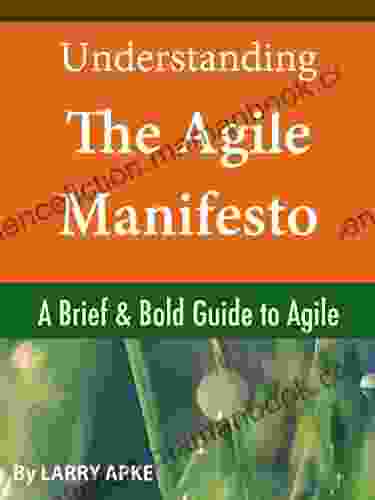A Comprehensive Guide to Agile: Principles, Benefits, and Implementation

In today's rapidly evolving business landscape, organizations are constantly seeking ways to adapt to change, deliver value quickly, and stay competitive. Agile has emerged as a powerful approach that empowers teams to navigate complexity, respond to customer needs, and achieve project success in a highly iterative and collaborative manner.
This comprehensive guide provides an in-depth understanding of Agile, its principles, benefits, and implementation strategies. By delving into the history, values, methodologies, and best practices of Agile, we aim to empower readers to effectively adopt and leverage Agile approaches to achieve project success.
The Agile Manifesto was introduced in 2001, marking a significant milestone in the development of Agile methodologies. It was a collaborative effort by 17 software development thought leaders who recognized the need for a more flexible and responsive approach to software development.
4.5 out of 5
| Language | : | English |
| File size | : | 772 KB |
| Text-to-Speech | : | Enabled |
| Screen Reader | : | Supported |
| Enhanced typesetting | : | Enabled |
| Print length | : | 46 pages |
| Lending | : | Enabled |
The Manifesto outlined four key principles:
- Individuals and interactions over processes and tools
- Working software over comprehensive documentation
- Customer collaboration over contract negotiation
- Responding to change over following a plan
These principles emphasized the importance of human collaboration, iterative development, customer feedback, and adaptability in software development projects.
Agile is founded on a set of core principles that guide its approach to project management and software development. These principles include:
- Iterative Development: Breaking down large projects into smaller, manageable chunks or iterations, allowing for continuous improvement and customer feedback.
- Incremental Delivery: Delivering working software early and often, enabling customers to experience value and provide feedback throughout the development process.
- Adaptive Planning: Embracing change and continuously adapting plans based on new information, customer feedback, and emerging risks.
- Teamwork and Collaboration: Fostering open communication, collaboration, and mutual support among team members, stakeholders, and customers.
- Customer Centricity: Keeping the customer at the heart of the development process, understanding their needs, and incorporating their feedback into product delivery.
Agile approaches offer numerous benefits for organizations and project teams, including:
- Increased Speed and Efficiency: Iterative development and incremental delivery enable faster time to market and improved productivity.
- Enhanced Quality: Continuous testing, customer feedback, and refactoring ensure high-quality software products.
- Improved Customer Satisfaction: Regular customer involvement and feedback loops lead to better alignment with customer expectations and increased satisfaction.
- Greater Flexibility and Adaptability: Agile approaches empower teams to respond quickly to changes in requirements, priorities, and market conditions.
- Increased Team Morale and Engagement: Open communication, collaboration, and self-organization foster a positive and motivated work environment.
There are various Agile methodologies that organizations can adopt to implement Agile principles in their projects. Some of the most popular methodologies include:
- Scrum: A framework for iterative and incremental development, emphasizing short sprints, daily stand-up meetings, and sprint retrospectives.
- Kanban: A visual management system that helps teams visualize their workflow and limit work in progress, improving flow and reducing bottlenecks.
- Lean: A set of principles and practices focused on waste reduction, value maximization, and continuous improvement.
- Extreme Programming (XP): A set of Agile practices that emphasize customer involvement, rapid feedback, and technical excellence.
Implementing Agile in an organization requires a systematic approach and a commitment to change. Key steps in the implementation process include:
- Establish a Clear Vision: Define the goals and benefits of Agile implementation for your organization.
- Assess Current Practices: Evaluate existing processes and identify areas for improvement.
- Select an Agile Methodology: Choose an Agile methodology that aligns with your organization's culture, project needs, and technical capabilities.
- Train and Educate Teams: Provide training and support to help teams understand and embrace Agile principles and practices.
- Establish Agile Infrastructure: Set up essential tools and infrastructure to support Agile development, such as project management tools, code repositories, and continuous integration systems.
- Monitor and Measure Progress: Track key metrics such as sprint velocity, defect rates, and customer satisfaction to assess Agile adoption and make necessary adjustments.
To ensure successful Agile implementation, consider the following best practices:
- Start Small: Begin by implementing Agile in a pilot project or team to gain experience and identify challenges.
- Involve Stakeholders: Engage stakeholders throughout the implementation process, including customers, users, and team members.
- Foster a Culture of Collaboration: Encourage open communication, trust, and mutual support among team members.
- Embrace Continuous Improvement: Regularly reflect on your Agile practices, identify areas for optimization, and make necessary adjustments.
- Measure and Adapt: Track key metrics and gather feedback to measure the effectiveness of your Agile implementation and make data-driven decisions.
Agile has become a transformative approach to project management and software development, empowering organizations to adapt to change, deliver value quickly, and achieve project success. By understanding the principles, benefits, and implementation strategies of Agile, organizations can effectively harness its power to gain a competitive advantage in today's digital age.
Remember, Agile is not just a set of rules or processes; it's a mindset that prioritizes collaboration, adaptability, and continuous improvement. By embracing Agile principles and tailoring them to your organization's unique needs, you can unlock its full potential and drive project success in a dynamic and ever-changing business landscape.
4.5 out of 5
| Language | : | English |
| File size | : | 772 KB |
| Text-to-Speech | : | Enabled |
| Screen Reader | : | Supported |
| Enhanced typesetting | : | Enabled |
| Print length | : | 46 pages |
| Lending | : | Enabled |
Do you want to contribute by writing guest posts on this blog?
Please contact us and send us a resume of previous articles that you have written.
 Top Book
Top Book Novel
Novel Fiction
Fiction Nonfiction
Nonfiction Literature
Literature Paperback
Paperback Hardcover
Hardcover E-book
E-book Audiobook
Audiobook Bestseller
Bestseller Classic
Classic Mystery
Mystery Thriller
Thriller Romance
Romance Fantasy
Fantasy Science Fiction
Science Fiction Biography
Biography Memoir
Memoir Autobiography
Autobiography Poetry
Poetry Drama
Drama Historical Fiction
Historical Fiction Self-help
Self-help Young Adult
Young Adult Childrens Books
Childrens Books Graphic Novel
Graphic Novel Anthology
Anthology Series
Series Encyclopedia
Encyclopedia Reference
Reference Guidebook
Guidebook Textbook
Textbook Workbook
Workbook Journal
Journal Diary
Diary Manuscript
Manuscript Folio
Folio Pulp Fiction
Pulp Fiction Short Stories
Short Stories Fairy Tales
Fairy Tales Fables
Fables Mythology
Mythology Philosophy
Philosophy Religion
Religion Spirituality
Spirituality Essays
Essays Critique
Critique Commentary
Commentary Glossary
Glossary Bibliography
Bibliography Index
Index Table of Contents
Table of Contents Preface
Preface Introduction
Introduction Foreword
Foreword Afterword
Afterword Appendices
Appendices Annotations
Annotations Footnotes
Footnotes Epilogue
Epilogue Prologue
Prologue Margaret Chukwu
Margaret Chukwu Ben Parris
Ben Parris Francisca Orellana Polanka
Francisca Orellana Polanka Don Colbert
Don Colbert David Burke
David Burke Red Passion Writings
Red Passion Writings Terry Masear
Terry Masear Shane Templeton
Shane Templeton Nikos Kazantzakis
Nikos Kazantzakis J H Leigh
J H Leigh Chris Thomerson
Chris Thomerson D J Butler
D J Butler Colleen Dorsey
Colleen Dorsey Elizabeth Hickey
Elizabeth Hickey Tara Brown
Tara Brown J A Jance
J A Jance Angus Curran
Angus Curran Karina Garcia
Karina Garcia Jennifer Joy
Jennifer Joy Garth Ennis
Garth Ennis
Light bulbAdvertise smarter! Our strategic ad space ensures maximum exposure. Reserve your spot today!

 Guillermo BlairPigeon Post Angie Griffin: A Historical Messenger's Extraordinary Journey of...
Guillermo BlairPigeon Post Angie Griffin: A Historical Messenger's Extraordinary Journey of... Manuel ButlerFollow ·12.7k
Manuel ButlerFollow ·12.7k Deion SimmonsFollow ·14k
Deion SimmonsFollow ·14k Troy SimmonsFollow ·18.1k
Troy SimmonsFollow ·18.1k Boris PasternakFollow ·2.1k
Boris PasternakFollow ·2.1k D'Angelo CarterFollow ·5.9k
D'Angelo CarterFollow ·5.9k Charles DickensFollow ·18.8k
Charles DickensFollow ·18.8k Jared PowellFollow ·3.1k
Jared PowellFollow ·3.1k Kenneth ParkerFollow ·6.2k
Kenneth ParkerFollow ·6.2k

 Ashton Reed
Ashton ReedClean(ish) Food for People Who Like to Eat Dirty
By: [Your Name] Are...

 Ronald Simmons
Ronald SimmonsThe Handbook for Educators: A Comprehensive Guide to...
The Handbook for...

 Derrick Hughes
Derrick HughesAny Place Hang My Hat: A Hauntingly Beautiful Novel by...
A Masterpiece of...

 Adrien Blair
Adrien BlairFly Me to the Moon Vol. 5: A Lunar Odyssey through...
In the vast...

 William Powell
William PowellTips By Gardeners On Variety Of Subjects
Gardening...
4.5 out of 5
| Language | : | English |
| File size | : | 772 KB |
| Text-to-Speech | : | Enabled |
| Screen Reader | : | Supported |
| Enhanced typesetting | : | Enabled |
| Print length | : | 46 pages |
| Lending | : | Enabled |












